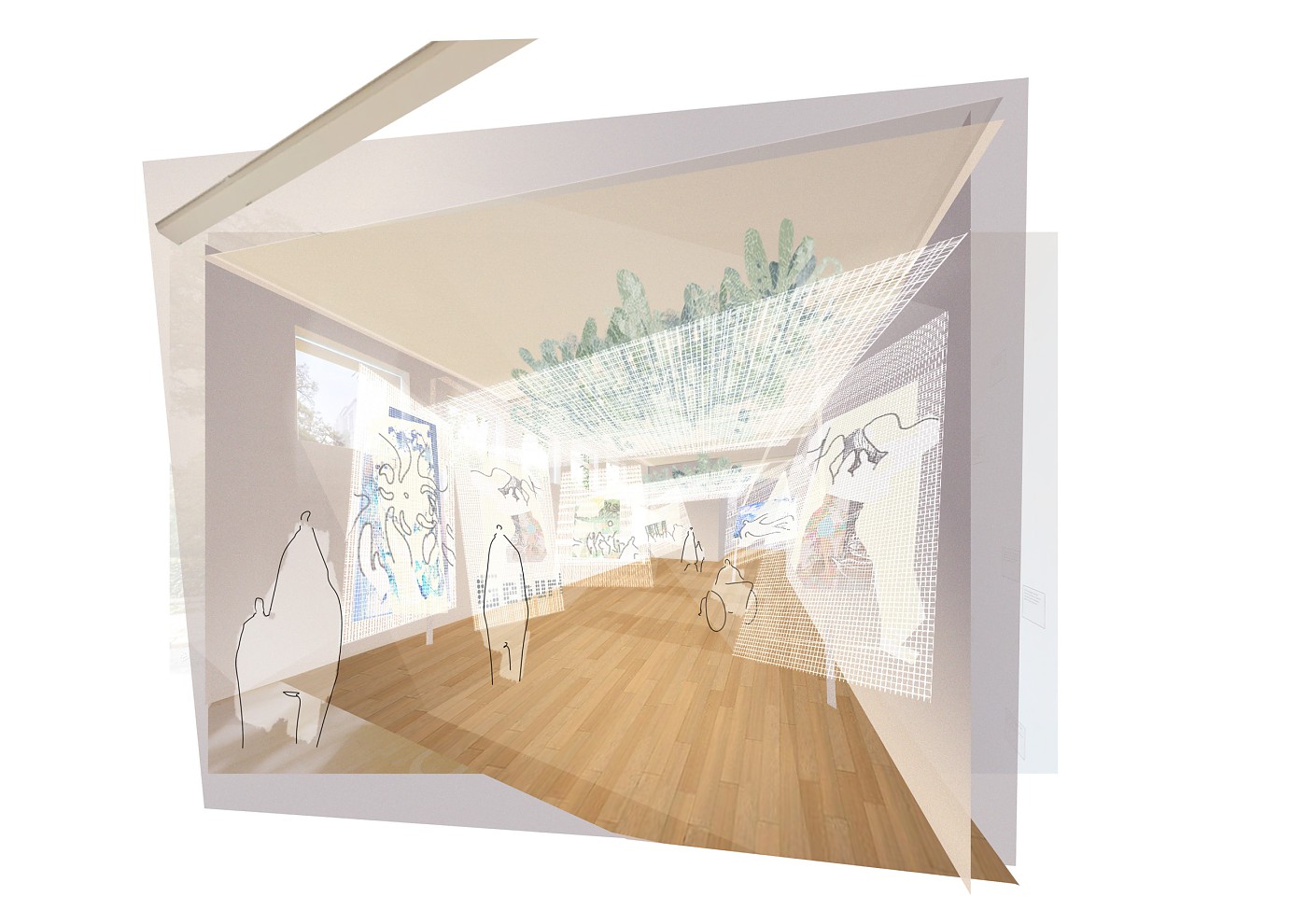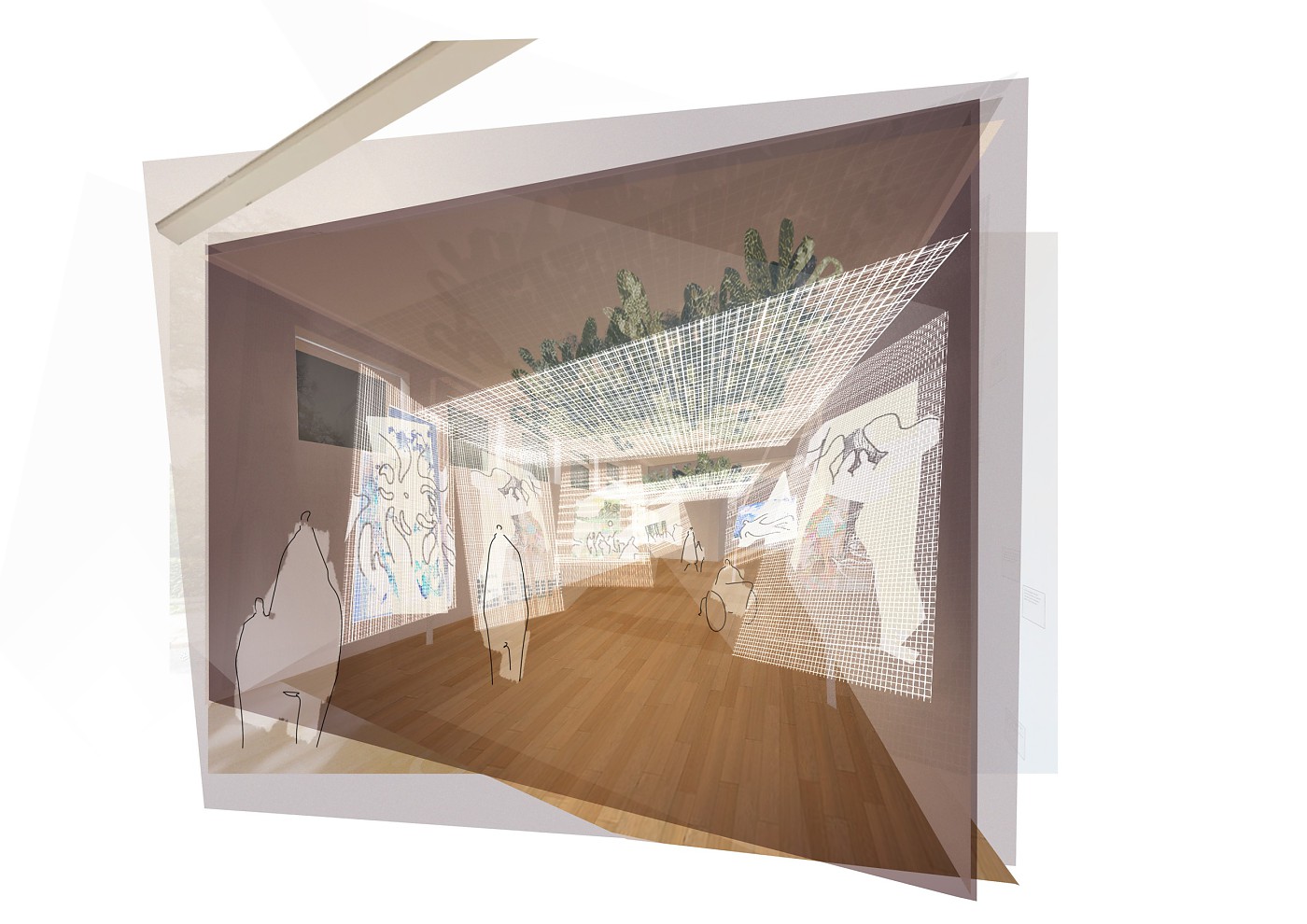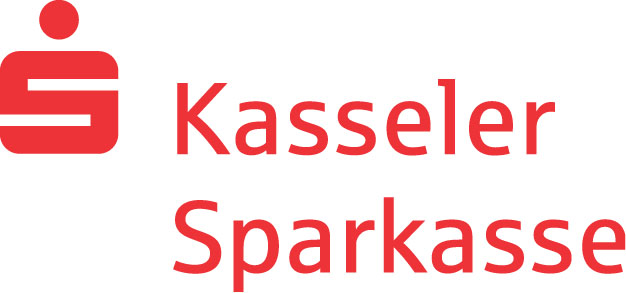Redesign
The Museum for Sepulchral Culture has existed since 1992 and is dedicated to the issues of dying, death, burial, mourning and remembrance. By providing information, advice and mediation in a varied programme of exhibitions and events, it is possible to initiate discourses that on the one hand accompany the change in sepulchral culture in a lively manner and on the other hand offer the opportunity for a conscious examination of one's own finiteness.
The central tasks of the Museum for Sepulchral Culture and the associated Central Institute are to research, promote and communicate the cultural heritage in the areas of burial, cemetery and monument conservation. They inform the public about the social consensus – but also about legitimate conflicts – on how to deal with dying, death and mourning, and illustrate the cultural-historical background and changes associated with this. The foundation of the museum is the sepulchral culture that has developed in the German-speaking world. Objects from the 15th century to the present day show how burials were held in Germany, how the dying was accompanied and how the deceased was remembered. Social changes, which in turn have an impact on the local burial culture, are also taken into account.
The maintenance, preservation, research and communication of German burial and cemetery culture make up a significant part of the work of the museum, the Central Institute and the sponsoring association. Not least because of these activities, cemetery culture in Germany was inscribed on UNESCO's national list of intangible cultural heritage on March 13, 2020. The federal government, the state of Hesse and the city of Kassel recognize this valuable work and its national significance and support the new conception through financial funding.
The redesign will further strengthen this cultural heritage through the expansion of the cultural education and mediation offer and the reorientation of the permanent exhibition. Among other things, a new focus will be placed on the permanent exhibition, which currently takes a back seat to the changing special exhibitions. The permanent exhibition plays a key role in familiarizing the public with the history, significance and development of sepulchral culture in Germany. Even more: The redesign takes particular account of the changes and diversification of society. It contributes to an overall societal understanding of a common sepulchral culture and thus also promotes the inclusion of citizens of different origins and world views.
As things stand, the museum will be temporarily closed for this purpose from the year 2025 in order to carry out the conversion work. However, it will not be completely inaccessible, as the team plans to transfer its events and exhibitions to other spaces within Kassel's city center. This will also provide an opportunity to encounter the museum's issues in a completely new location.
The reopening is then expected to take place in 2027.
Since the entire project is still in the planning stage, all progress and dates will be posted here in the future.
"In order to give the museum with its topic the opportunity to really have an impact on society, it should become an even stronger meeting place than it already is"
Director Dr. Dirk Pörschmann
Scientific Advisory Board
The Museum Advisory Board is in the process of being reconstituted. Its first major project will be the redesign of the museum.
In order to meet the constant changes in cemetery and burial culture and the resulting changing demands of museum visitors on the mediation work in our institution, it became urgently necessary to update the permanent exhibition of the Museum for Sepulchral Culture. For this purpose, a temporary "Scientific Advisory Board for the Redesign of the Permanent Exhibition of the Museum for Sepulchral Culture" was founded for the first time in 2017.
View List
Birgit Heller
Position: Deputy Director of the Institute for Religious Studies University of Vienna
Redesign of the permanent exhibition
Looking back a few years, the starting point for the upcoming redesign is the need to renew our permanent exhibition – in terms of content as well as aesthetics and function. In the course of the expansion and fundamental renovation, it is therefore also necessary to redesign the permanent exhibition, which has not undergone a fundamental redesign since the museum opened in 1992. The focus is on updating the contents with a view to the present and current developments in sepulchral culture, and especially on the cultural, ethnic and religious diversity of our sepulchral culture, as well as on developing suitable ways of addressing and involving visitors. The visitor experience for children and young people is also to be improved.
In addition, the special exhibition areas and functional areas are to be reorganized in order to improve the visitor experience. For example, there will be a new space on the terrace that can be used for events. An open courtyard, bar, additional restrooms, and an expanded store will round out the welcome to the museum – even if (this time) you just want to grab a coffee and enjoy the view. Special exhibitions will be given different spaces than before, allowing for a broader interplay of focus exhibitions.
We are excited!
gewerkdesign from Berlin responsible the design of the permanent exhibition
In the fall of last year, the team for the redesign of the Museum for Sepulchral Culture was expanded to include the architects of the Schulze Berger office. Now, in spring 2023, the decision has finally been made as to who will be responsible for the redesign of the new permanent exhibition and the first special exhibition after the reopening. Thus, the most eagerly awaited visions and people have been named and are at work. The Berlin office gewerkdesign will accompany us in the coming years to guide our (and new) themes and objects into a fresh, contemporary exhibition.
"At gewerkdesign, we understand scenographic design as a language that grasps, translates and conveys complex content. In addressing the thematic complex of sepulchral culture, it was important to us to bring about a change in perspective for visitors* and to reset the themes to which the museum is committed in terms of conservation, education and discourse."
Stefan Rothert, gewerkdesign
Opening space by day and by night, projection of the scenes on air-permeable mesh (sketch)
© 2023 gewerkdesign Berlin
About the competition
As with the conversion and refurbishment, the decision was made by means of a Europe-wide competition for designers. The design competition was organized as a two-stage process in which five of the 30 offices that applied qualified for further participation. These five offices were then given the task of developing a concept for two stations of the future permanent exhibition. A so-called prelude sequence was worked on without any further restriction with regard to thematic focus or object selection, as well as our historical series of figures of the "Zizenhausen Dance of Death". In addition to the designs, the project management skills of the potential project leaders were also evaluated. In this way we were able to get to know the handwriting and working methods of our new partners. The participants received an allowance of €5,000 for their concept work. The entire process was carried out along the new fee structure for exhibition design (HOAS), which has been in place since 2019.
"With this basis, we were able to implement the procedure and selection to a high degree of transparency and fairness," said Dr. Stefan Kleßmann, who is responsible for competition management and also developed the HOAS. "Furthermore, special attention was paid to giving small and medium-sized design offices a good chance to win this challenging contract."
Dr. Stefan Kleßmann
About the concept
"The design and structure of the exhibition is based on the impetus to bring dying, mourning and death into a dialogue close to everyday life and also to take the perspective of the visitors. With our design we would like to create offers for a personal and social confrontation with the topic and hope to be able to give an impulse for discourses and reflection processes. The basic conceptual idea for the redesign of the exhibition is to create different, freely selectable approaches in the form of walk-through scenographic sculptures that focus on the visitors who pass through them. The existing architecture of the museum building by Wilhelm Kücker was both inspiration and didactic maxim. The light-flooded glass building with its different levels and views convinces with its multi-perspectivity and is itself a walk-in sculpture.
Overall, the redesign of the exhibition pursues the goal of making the examination of sepulchral culture accessible to a broad audience while leaving room for subjective perspectives and social change. We look forward to implementing this project over the next three years, together with the curatorial team as well as the museum management and taking into account the plans of the architectural firm Schulze Schulze Berger."
gewerkdesign
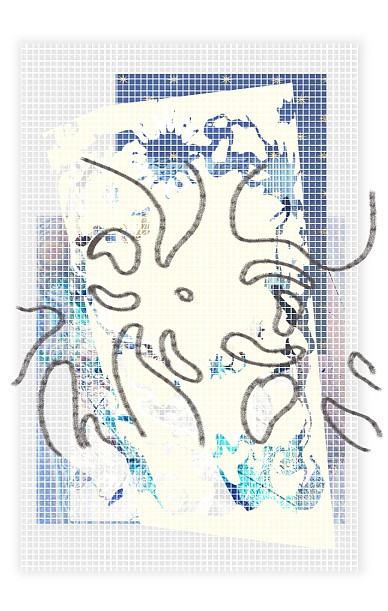
© 2023 gewerkdesign Berlin
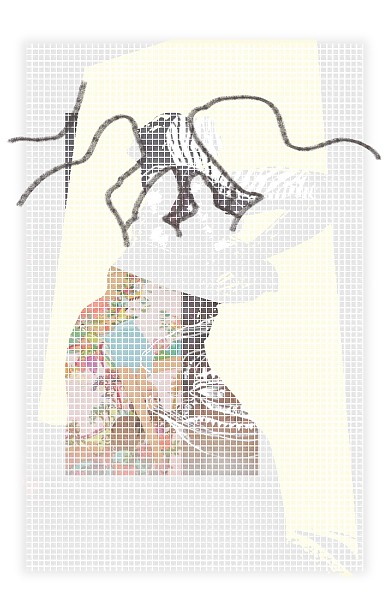
© 2023 gewerkdesign Berlin
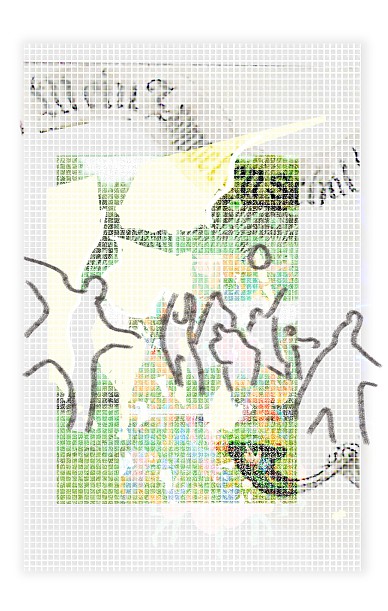
© 2023 gewerkdesign Berlin
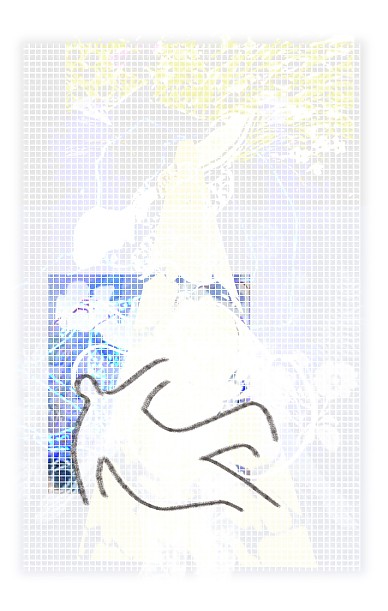
© 2023 gewerkdesign Berlin

© 2023 gewerkdesign Berlin
About gewerkdesign
"Since 1992, the interdisciplinary design office gewerkdesign has been developing tailor-made solutions for exhibition spaces, graphics, products, media applications and other projects, integrating creative means from all disciplines of design, from architecture and scenography to industrial and graphic design. The work of the Berlin design office is characterized above all by an integrative, conceptual approach and an intensive preoccupation with the respective application spaces, situations and content-related topics of the projects and their clients.
Effective design is understood as a dynamic process, which is characterized in particular by the consideration of the different perspectives of all those involved in a project and thus by a bundling of knowledge and competences. gewerkdesign supervises all phases of a project, from basic research to design and implementation."
gewerkdesign
VISIONS FOR THE FUTURE
Opened in 1992, the Museum consists of the listed remise of the former villa of the industrialist Henschel family from 1903/1904 and an associated new building by architect Wilhelm Kücker (Munich). Three decades after its opening, the building and museum are in need of fundamental renovation, comprehensive technical upgrading and reorganization.
Kassel office wins architectural competition for Museum for Sepulchral Culture
The first prize in the competition for the new conception, renovation and expansion of the Museum for Sepulchral Culture (MSK) in Kassel goes to the office Schulze Berger Architekten Stadtplaner BDA PartGmbB. This and two other prize winners were selected by the jury chaired by Prof. Zvonko Turkali. The funds for the preliminary planning are provided by the state of Hesse (759,000 euros) and the city of Kassel (50,000 euros).
"The Museum for Sepulchral Culture does very special work on a sensitive topic that we often block out of our lives, illuminating death and how we deal with it from different perspectives," explains Angela Dorn, Hesse's Minister for Science and the Arts. "With the planned expansion, the museum will have the opportunity to design even more attractive offerings for visitors. And the planning perspective strengthens – and this particularly pleases me as Minister for Arts and Science – the research work of the Institute. Since the protection of historical monuments also falls under my department, I would also like to emphasize the careful as well as conscious handling of the listed inventory and the creative emphasis on historical references of the winning design."
"The Museum for Sepulchral Culture deals with the themes of death and dying and their social discourses, cultural and historical dimensions, and personal issues in a way that is both approachable and innovative," adds Dr. Susanne Völker, head of the Cultural Department of the City of Kassel. "The renovation opens up contemporary possibilities for the further development of exhibitions, research and outreach in a museum that is as exceptional as it is relevant in its thematic focus."
"For our unique institution, the result of the competition is a major step towards leading our house into the future and further strengthening the regional and national significance of the Museum and Central Institute for Sepulchral Culture. This will enable us to continue working on a contemporary awareness of finitude in a socially relevant way," says Dr. Dirk Pörschmann, Director of the Museum.
The winners – 1 to 3
The first prize was awarded to the Schulze Berger Architekten Stadtplaner BDA PartGmbB from Kassel for their proposal to build a multifunctional room over the terrace in the style of the historical situation, which can be used for all types of events or can also be added to the café. It offers visitors a view of Kassel's southern city and the Fulda floodplain. The historic gateway will be reactivated as an entrance and will lead into the inner courtyard, which in the future will be free of fixtures and roofing and will allow visitors to experience the historic structure of the Remisen building again. Here, groups of visitors can gather and prepare for their visit to the museum or guests can stop to visit the café or the museum store. In the jury's view, this work does a particularly good job of ensuring that the event area can be used independently of museum operations.
The 2nd prize went to Osterwold+Schmidt architects from Weimar for the idea of completely building over the inner courtyard with a multi-storey wooden structure that accommodates the required space program. By compressing the structural addition above the current inner courtyard, the addition of a new roof can be reduced to a minimum and a generous roof terrace with an impressive distant view can be offered. The roof addition is thereby limited to the multifunctional area exposed in the center. The gateway becomes the main entrance, leading visitors to a spacious foyer on the site of the current courtyard.
The 3rd prize was won by the office of Peter Zirkel Architekten from Dresden, who strengthened the connection between the old and new buildings with a large-scale opening of the historic east facade of the remise – which became an interior wall due to the new museum building by Wilhelm Kücker. For this purpose, the current access system in the so-called joint between the building parts will be completely changed. The newly created inner axis is intended to bring light and air into the overall ensemble and enable new spatial experiences, while accepting considerable interventions in the historic building fabric.
About the competition
The competition was announced as a restricted realization competition in an anonymous procedure with a preliminary application procedure. A total of twelve offices from Germany and abroad took part. The jury was supported by a large number of experts from the fields of monument preservation, culture and museums, the specialist departments of the city of Kassel, the federal, state and city funding agencies and the Arbeitsgemeinschaft Friedhof und Denkmal e.V. (Working Group Cemetery and Monument). The competition was organized by the ANP office from Kassel.
Commenting on the competition process, the chairman of the jury, Prof. Zvonko Turkali, adds: "The entries submitted are all of a very high quality. The work awarded first prize provides an excellent basis for the careful renovation of the existing building and its clear functional upgrading. The planned structural measures create spatial situations that make the museum an attractive and at the same time distinctive place."
About the concept
The competition task focused on the structural and spatial tasks in both parts of the building. The focus of the restructuring is on the listed remise with a new event area, conference and seminar rooms, library, reception with museum store and administrative rooms. In the new building, the indoor climate situation is to be improved and a functional upgrading of the building in aesthetic harmony with the old building is to be made possible.
Particular attention is paid to doing justice to the historic building and sensitively addressing both the original substance and the traces of the overbuilding from the post-war period and the new museum building from the 1980s/ 1990s.
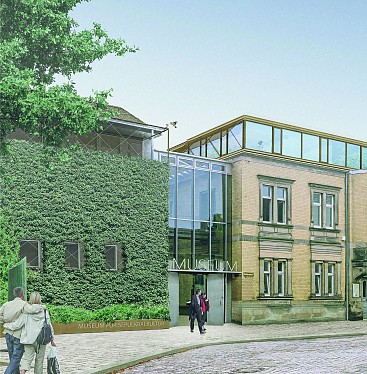
Schulze Berger Architekten Stadtplaner BDA PartG mbB
© Museum für Sepulkralkultur, Kassel, Bildarchiv
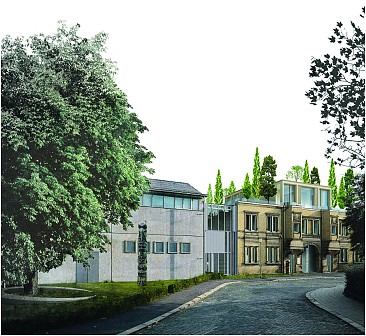
Osterwold+Schmidt-Architekten, Weimar
© Museum für Sepulkralkultur, Kassel, Bildarchiv
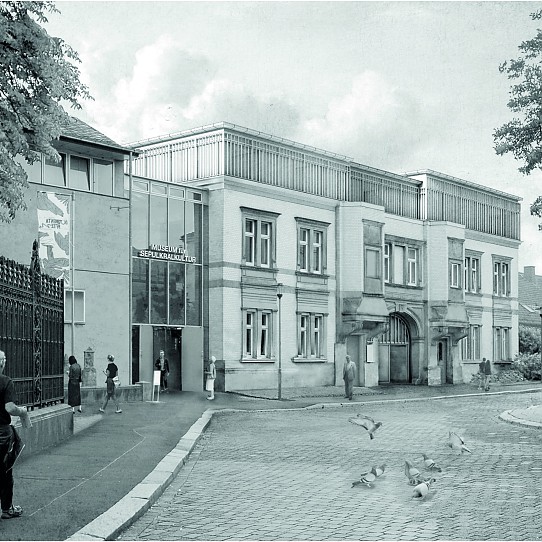
Büro Peter Zirkel Architekten, Dresden
© Museum für Sepulkralkultur, Kassel, Bildarchiv
7 Million for Redesign and Refurbishment
29th November 2019
Implementation of the "Vision for the Future" is approaching:
The German Parliament provides the Museum for Sepulchral Culture Kassel with 7 million euros
The Museum for Sepulchral Culture in Kassel, which opened in 1992, receives 50 percent of the investment costs (total costs 14 million euros) from federal funds, which are necessary for the new concept of the permanent exhibition, energy-saving renovation and expansion of the functional areas. The funds are provided from the budget of the Commissioner for Culture and Media, Minister of State Prof. Monika Grütters.
Prof. Monika Grütters: "The Museum for Sepulchral Culture lives from its unusual issue. It has thus developed into an extraordinary place of culture and remembrance and impressively proves that the themes of dying, death, mourning and burial are an integral part of our culture. With this elementary topic, the museum appeals to all of us without distinction. When it comes to the great question of the beginning and end of life, to thoughtfulness, contemplation and transcendence, it always touches its visitors deeply. Because of the importance of this theme, the Confederation is happy to participate in the renovation of the museum."
The Museum for Sepulchral Culture has existed as a cultural institution of national importance since 1992 and was affiliated to the Central Institute for Sepulchral Culture, which was founded in 1979. The museum focuses on the topic of funeral culture and illustrates continuities and breaks in dealing with dying, death, burial, mourning and remembrance. Architecturally, the museum consists of the historical existing building – the former shed of the Henschel villas (1903/1904) – and the adjoining new museum building, which combines both units into a significant ensemble in terms of urban development.
After almost three decades of operation, this unique museum needs a new concept for its permanent exhibition that reflects the current state of social discourse and scientific research. In addition, a fundamental renovation is required, and in particular an elementary improvement of the air conditioning and ventilation technology to meet the energy and conservation requirements of contemporary museum operations.
Director Dr. Dirk Pörschmann: "The fact that our museum is now receiving financial support for the urgently needed updates to the permanent exhibition and the renovation and extension work is a great fortune and a credit to the whole team. In many years of creative and constant work, the Museum for Sepulchral Culture has established itself as a unique institution nationwide. We work for society by bringing the themes of dying, death, burial and mourning into people's consciousness in a variety of ways."
The new conception of the content conveys the multifaceted relationship between man and death. This is illustrated in particular against the background of demographic development and migration movements by current multicultural, ethical, sociological, medical, socio-psychological, theological and scientific aspects in dealing with dying and death.
Kassel's SPD member of the German Parliament Timon Gremmels and Kassel's Lord Mayor Christian Geselle did not miss the opportunity to attend the opening evening of the exhibition "LAMENTO. Trauer und Tränen" (15.11.2019) to share with the assembled audience their great joy about the approval of federal funding. In addition, budget funds have already been promised by the City of Kassel. Susanne Völker, head of the Department of Culture, emphasized: "The Museum for Sepulchral Culture occupies a special position in the German museum landscape. With its focus on content, the museum touches on central aspects of human existence, which are often given little space in our modern society. Since its foundation 27 years ago, the museum has continually opened up innovative, informative and life-affirming perspectives through a wide range of exhibitions and events. I am pleased that the Museum for Sepulchral Culture is now being given a perspective for modernization and contemporary development".
Negotiations are currently taking place with the museum's institutional sponsor, the State of Hesse, in order to have planning security soon. Eva Kühne-Hörmann, Hesse's Minister of Justice and Kassel CDU chairwoman, said that the museum is, in addition to the documenta, "another cultural institution unique in Germany", which has its headquarters in Kassel. From 2017 to 2018, the Protestant Church of Germany (EKD) and the Association of German Dioceses (VDD) had provided financial support for the development of the "Vision for the Future" which is now available. The Museum for Sepulchral Culture hopes to receive further support from the two Christian churches in the area of the costs of setting up the updated permanent exhibition, as well as from a wide range of sponsors and donors, in order to be able to raise the necessary own contribution.
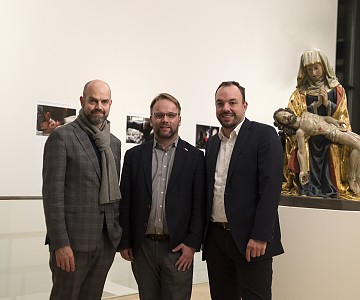
Photo: Maja Wirkus
© Museum für Sepulkralkultur, Kassel, Bildarchiv
On our press page you will find high-resolution images and other press information. You can also apply for press access there.
Habe Museum, suche Räume!
Das Museum für Sepulkralkultur braucht ein Interim
Wir halten Sie an dieser Stelle über unsere Präsenz ab Baubeginn auf dem Laufenden!
Da neben der Verwaltung und den Lagerflächen auch die gesamte Ausstellungsfläche temporär geräumt werden muss, möchte das Museum zwischen Anfang 2025 und Herbst 2027 Interimsräume im Kasseler Innenstadtbereich bespielen.
Diese Maßnahme ist von großer Bedeutung für das weltweit einmalige Museum für Sepulkralkultur. Es soll die permanente Verfügbarkeit für Interessierte und nicht zuletzt seine Sichtbarkeit in der Gesellschaft aufrechterhalten.
Raumbedarf
Für den Zeitraum der Auslagerung strebt das Museum eine Fläche an, die über folgende Kriterien verfügen sollte:
Gute Sichtbarkeit in der Kasseler Innenstadt
- Fläche von ca. 200m²
- Nutzbarkeit für Veranstaltungen
- Anliefermöglichkeit
- Geeignete Sanitäranlagen
- Geeignetes Sicherheitslevel zum Schutz von technischem Equipment und Exponaten
(Alarmanlage nicht zwingend, Abschließbarkeit zwingend)
Für den Ausstellungs- und Veranstaltungsbesuch würden keine Eintrittsgelder erhoben werden, daher ist ein Kassenbereich nicht nötig.
Contact
Arbeitsgemeinschaft Friedhof und Denkmal e. V.
Telefon: 0 561 / 918 93 0
Fax: 0 561 / 918 93 10
Weinbergstraße 25-27
34117 Kassel
Sponsoring wanted!
The project "new conception" is supported with about 14 million by the federal government, the state of Hesse and the city of Kassel. If this sum is exceeded, the building owner must and will bear the costs incurred.
Construction cost increase
The project is characterized in particular by its multifaceted nature, which presents the scientific team with ever new challenges, but also joys, such as the "visions for the future". The long planning phase, which was affected by unforeseen cutbacks such as the delays caused by the Corona pandemic, has also contributed to our need for further funding. In particular, the aspect of increased construction costs, which were only factored into the original rough cost estimate from 2019, when the end of the project was set even earlier, through 2024, represents an additional financial burden.
Contact for sponsors
Arbeitsgemeinschaft Friedhof und Denkmal e. V.
Telefon: 0 561 / 918 93 0
Fax: 0 561 / 918 93 10
Weinbergstraße 25-27
34117 Kassel
Project management
One item that cannot be covered in principle by our sponsors is a project management for the new conception. For every exhibition and every project at the Museum for Sepulchral Culture, a project manager is appointed from within the team or externally, who brings together the countless threads and keeps an eye on the progress and success in terms of content and administration. Paradoxically, this is not guaranteed by our sponsors, especially for this complex and long-term large-scale project. A new position created for this purpose was not filled until the beginning of 2023. This was made possible for twelve months by the sponsorship of the Ahorn Group, the Friends of the Museum for Sepulchral Culture and the Kassel-based banks Sparda-Bank Hessen eG, Kasseler Sparkasse and Evangelische Bank eG. For this, we thank the aforementioned very warmly and with an audible sigh of relief. After the first twelve months have been financed, we already have to start looking for sponsors again with much too fast steps, because the urgency of a project management position remains until the realization of the project and the reopening of the museum in late summer 2027.
Wir danken unseren bisherigen Sponsor*innen:
Ahorn Gruppe
The Ahorn Group currently unites more than 65 funeral brands and over 270 branches in Germany under its roof. In the course of its history, it has buried well over 2.5 million people and accompanied their relatives. It has grown through mergers over two centuries and has evolved thanks to new people, new tasks and new ventures. The employees are united by the common mission of taking their responsibility as market leader towards the deceased and mourners seriously.
Sparda-Bank Hessen eG
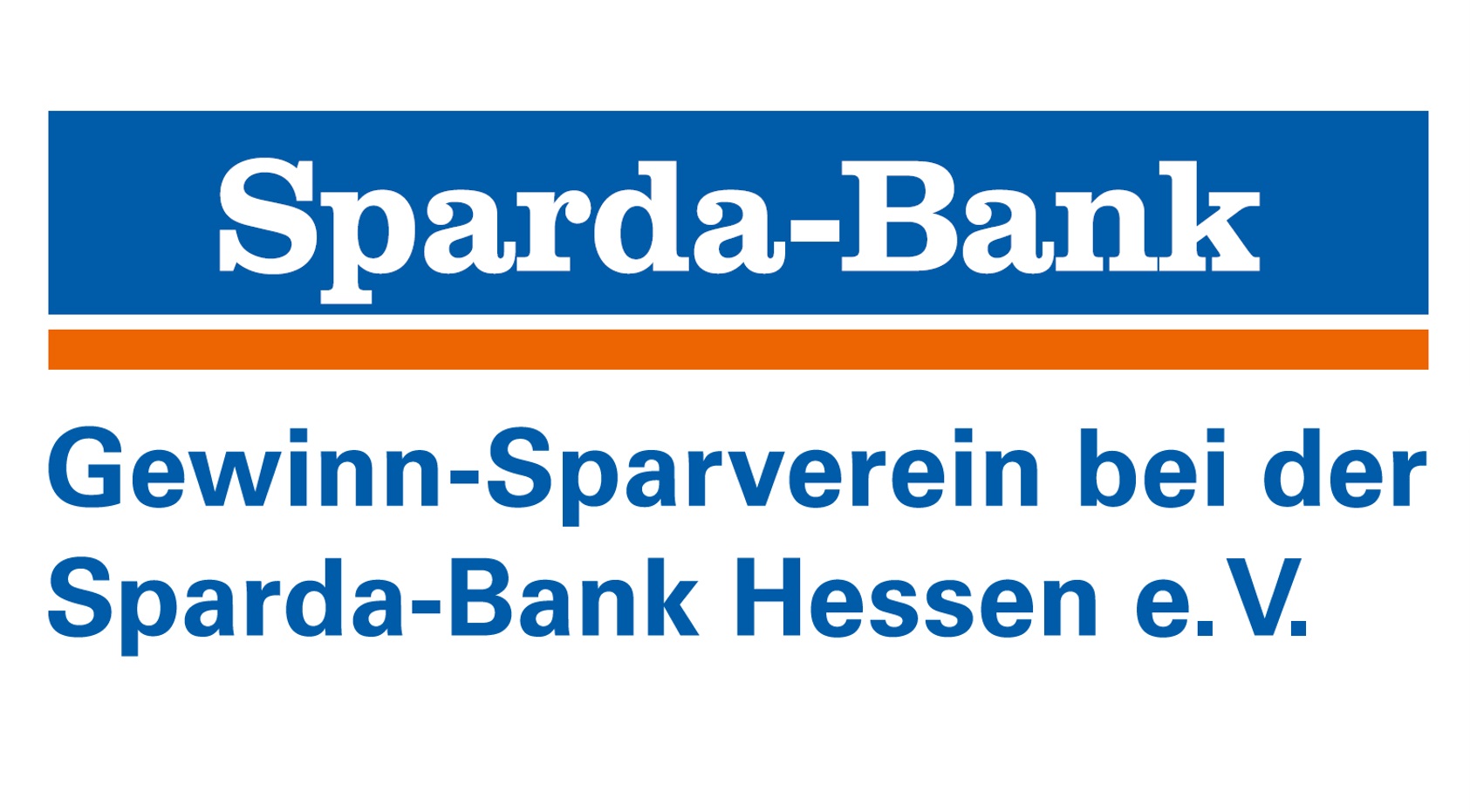
Kasseler Sparkasse
As a leading financial services provider, Kasseler Sparkasse also assumes social responsibility and invests a significant portion of its earnings in charitable projects run by associations in the city and district. The funding flows into the areas of culture, science, social affairs and sports. In 2022, Kasseler Sparkasse supported more than 643 projects with 1,337,000 euros.
Evangelische Bank eG
Sustainability under social and ethical responsibility is the focus of all donations by Evangelische Bank. All donations benefit projects that make a strong contribution to humanity, mindfulness and solidarity.
Circle of Friends of the Museum for Sepulchral Culture
The Circle of Friends of the Museum for Sepulchral Culture supports outstanding projects of the museum with the annual contributions of its members, donations and commitment.
Interim rents
Also not sufficiently funded are rents for interim rooms, which we urgently need in order to maintain the museum's visibility. Here we are dependent on support in order not to have to stop our activities in the areas of exhibition, mediation, further education and events during the entire construction phase. As we are the only museum for sepulchral culture worldwide, closure is not an option.
Collection
Another point, which explicitly can only be made possible by sponsoring, is the expansion of our collection. So far, through its tradition since the foundation of the Central Institute for Sepulchral Culture in 1979, it has a focus on Christian occidental traditions and objects. Instead, the sepulchral culture of a society in Germany, within which the culture of action, reaction and objects is presented as diverse by the diversity of society itself, is now moving into focus. For this purpose, it is necessary to add appropriate objects to the collection in order to be able to convey practices of different and intertwined religious and cultural imprints. The museum can and would like to contribute to a societal understanding of a common sepulchral culture and promote a sense of community among citizens of different origins and world views.
Therefore, we are very grateful for any commitment that helps us to finance our project for the coming years!
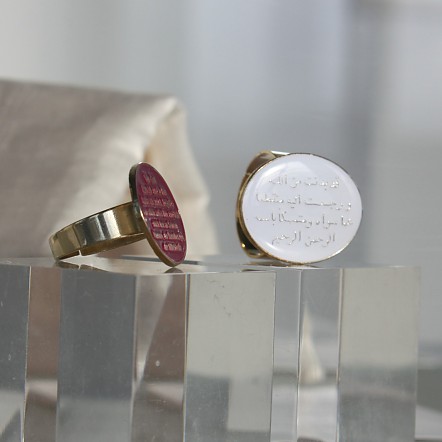
Arbeitsgemeinschaft Friedhof und Denkmal e.V.
Zentralinstitut für Sepulkralkultur
Museum für Sepulkralkultur
Weinbergstraße 25–27
D-34117 Kassel | Germany
Tel. +49 (0)561 918 93-0
info@sepulkralmuseum.de







